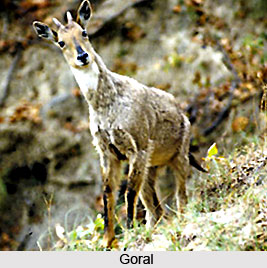
Gorals are small ungulates that belong to the Bovidae family, closely related to goats and antelopes. They exhibit a sturdy build with a stocky body, short legs, and a compact stature. Adult gorals typically stand about 60-75 cm at the shoulder and weigh between 20-30 kg. Their fur is dense and coarse, generally gray or brown with a lighter underbelly, providing effective camouflage in their natural habitat. Gorals possess distinctive physical characteristics including small, pointed horns that curve backward, and a short, bushy tail. Both males and females have horns, although the males' are slightly larger. Their hooves are adapted for climbing steep, rocky terrain, aiding their agility and sure-footedness in their mountainous environments.
Habitat
Gorals are primarily found in mountainous regions, preferring rugged, rocky slopes and forested areas at high altitudes. They inhabit a range of altitudes from 1,000 to 4,000 meters above sea level. These animals are well-adapted to cold climates and can often be found in alpine and subalpine zones. Their habitats are typically characterized by a mix of cliffs, steep slopes, and dense vegetation, which provide them with both shelter and foraging opportunities. Gorals are herbivorous, feeding on a variety of grasses, leaves, and twigs. They are crepuscular, being most active during the early morning and late afternoon, which helps them avoid predators and the midday heat.
Concentration in India
In India, gorals are found in several northern and northeastern states, inhabiting the Himalayan ranges. The three main species present in India are the Himalayan goral (Naemorhedus goral), the red goral (Naemorhedus baileyi), and the long-tailed goral (Naemorhedus caudatus).
Himalayan Goral (Naemorhedus goral): This species is the most widespread and is predominantly found in the states of Jammu and Kashmir, Himachal Pradesh, Uttarakhand, Sikkim, and Arunachal Pradesh. They inhabit elevations ranging from 1,000 to 4,000 meters. The population is relatively stable but faces threats from habitat loss and poaching.
Red Goral (Naemorhedus baileyi): The red goral is less common and is primarily found in the northeastern state of Arunachal Pradesh. It prefers higher altitudes, typically above 2,500 meters. The red goral is distinguished by its reddish coat and is considered more elusive compared to its counterparts.
Long-tailed Goral (Naemorhedus caudatus): This species is found in smaller populations and is primarily located in the eastern Himalayas. It inhabits similar terrains as the other species but is more challenging to observe due to its secretive nature and fragmented populations.
Conservation Status
Gorals in India face several conservation challenges, primarily due to habitat destruction, poaching, and competition with livestock. Their natural habitats are increasingly encroached upon by human activities such as agriculture and development. Despite these pressures, efforts are being made to protect and conserve goral populations. Several protected areas and wildlife sanctuaries within their range provide a refuge for these animals. Conservation programs focus on habitat preservation, anti-poaching measures, and community awareness to ensure the survival of these unique and agile mountain ungulates.
Gorals are an integral part of India's mountainous
ecosystems. Their physical adaptations make them well-suited to the rugged
terrain and harsh climates of the Himalayas. However, ongoing conservation
efforts are essential to mitigate the threats they face and to preserve their
populations for future generations.